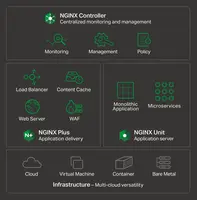Overview
What is NGINX?
NGINX, a business unit of F5 Networks, powers over 65% of the world's busiest websites and web applications. NGINX started out as an open source web server and reverse proxy, built to be faster and more efficient than Apache. Over…
Recent Reviews
Awards
Products that are considered exceptional by their customers based on a variety of criteria win TrustRadius awards. Learn more about the types of TrustRadius awards to make the best purchase decision. More about TrustRadius Awards
Popular Features
- Installation (18)9.494%
- Application server performance (18)8.686%
- Administration and management (18)8.080%
- Security management (18)8.080%
Reviewer Pros & Cons
Pricing
Entry-level set up fee?
- Setup fee optional
For the latest information on pricing, visithttps://www.nginx.com/products/pricing
Offerings
- Free Trial
- Free/Freemium Version
- Premium Consulting/Integration Services
Would you like us to let the vendor know that you want pricing?
25 people also want pricing
Alternatives Pricing
Product Demos
CVE-2016-1247 Nginx (Debian-based) Vulnerability - Root Priv. Escalation PoC Exploit Demo
YouTube
Nginx Web Server configuration with Examples
YouTube
Load Balancing with NGINX
YouTube
Access your internal websites! Nginx Reverse Proxy in Home Assistant.
YouTube
How to Serve Static Content
YouTube
Using NGINX Open Source for Video Streaming and Storage
YouTube
Features
Return to navigation
Product Details
- About
- Integrations
- Competitors
- Tech Details
- FAQs
What is NGINX?
NGINX, a business unit of F5 Networks, powers over 65% of the world's busiest websites and web applications. NGINX started out as an open source web server and reverse proxy, built to be faster and more efficient than Apache. Over the years, NGINX has built a suite of infrastructure software products o tackle some of the biggest challenges in managing high-transaction applications.
NGINX offers a suite of products to form the core of what organizations need to create applications with performance, reliability, security, and scale. This includes NGINX Plus for load balancing, reverse proxy, and application delivery controller features, NGINX App Protect for high performance web application firewall security, and NGINX Unit to run the application code, all monitored and managed by the NGINX Controller.
- NGINX Plus: An all‑in‑one load balancer, web server, and content cache.
- NGINX Controller: Centralized monitoring and management for NGINX Plus.
- NGINX App Protect: Web application firewall, powered by F5
- NGINX Unit: Lightweight application server, with support for multiple languages and a dynamic REST API‑driven configuration
- NGINX Ingress Controller: Traffic management solution for cloud‑native apps in Kubernetes and containerized environments.
- NGINX Service Mesh: Lightweight, Turnkey, Developer-Friendly Service Mesh Using NGINX Plus as an Enterprise Sidecar
NGINX Features
Application Servers Features
- Supported: IDE support
- Supported: Security management
- Supported: Administration and management
- Supported: Application server performance
- Supported: Installation
- Supported: Open-source standards compliance
Additional Features
- Supported: NGINX: Fast, light web server and reverse proxy
- Supported: NGINX Plus: All‑in‑one Load Balancer, Web Server, and Content Cache
- Supported: NGINX Plus: Security controls, High Availability, Dynamic Modules
- Supported: NGINX App Protect: Layer 7 Attack Protection
- Supported: NGINX Controller: Centralized Traffic Management and Monitoring
- Supported: NGINX Controller: Role-based Access Controls
- Supported: NGINX Unit: Multi-language Application Server
NGINX Screenshots
NGINX Integrations
- Microsoft Azure
- Mirantis Kubernetes Engine
- Kubernetes
- ForgeRock Identity Platform
- Amazon Elastic Compute Cloud (EC2)
- Red Hat Enterprise Linux (RHEL)
- DeviceAtlas
- Red Hat OpenShift
- Google Cloud Platform
- OpenStack
- Cedexis
- IDFConnect
- PingIdentity
- Phusion Passenger
- Stealth Security
NGINX Competitors
NGINX Technical Details
| Operating Systems | Unspecified |
|---|---|
| Mobile Application | No |
Frequently Asked Questions
Microsoft IIS and HAProxy Community Edition are common alternatives for NGINX.
Reviewers rate Installation highest, with a score of 9.4.
The most common users of NGINX are from Mid-sized Companies (51-1,000 employees).
NGINX Customer Size Distribution
| Consumers | 0% |
|---|---|
| Small Businesses (1-50 employees) | 0% |
| Mid-Size Companies (51-500 employees) | 50% |
| Enterprises (more than 500 employees) | 50% |















